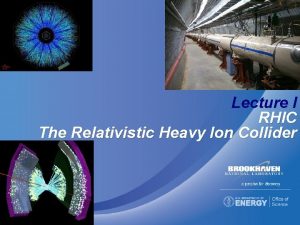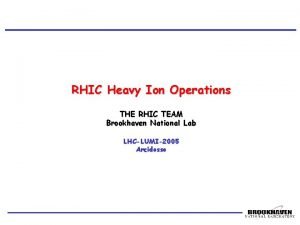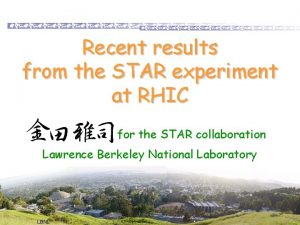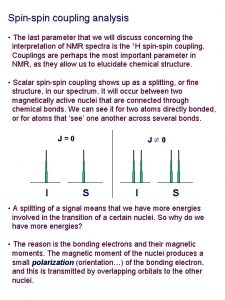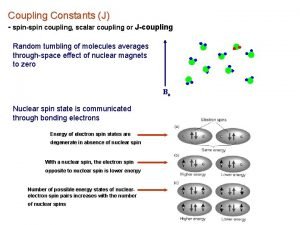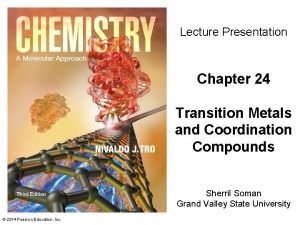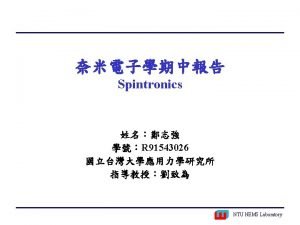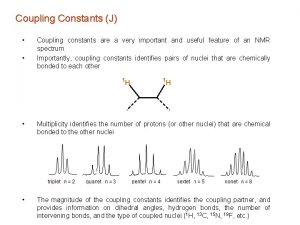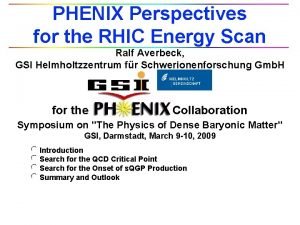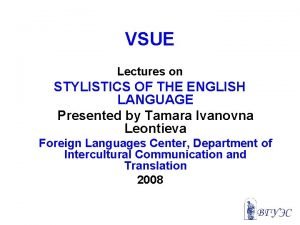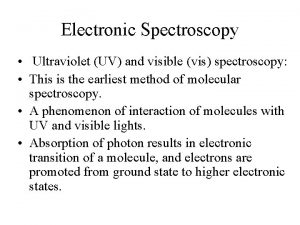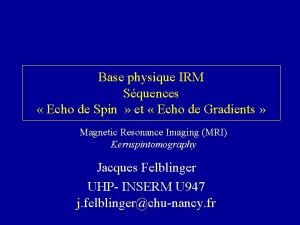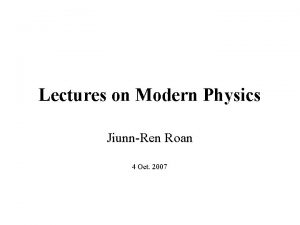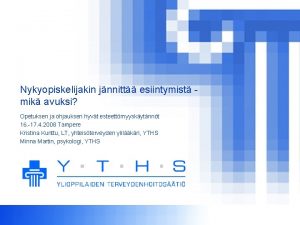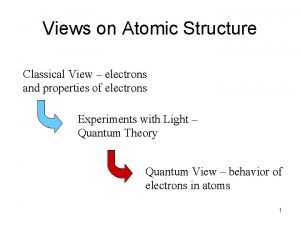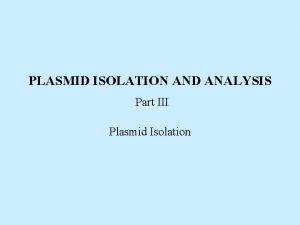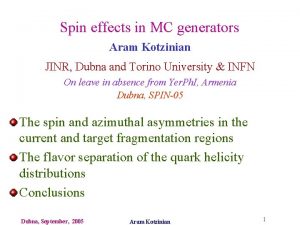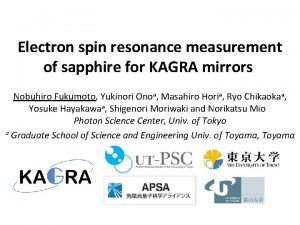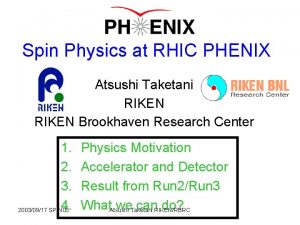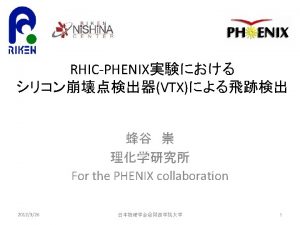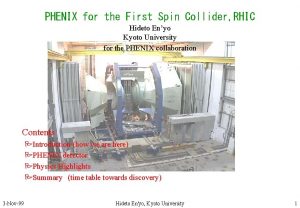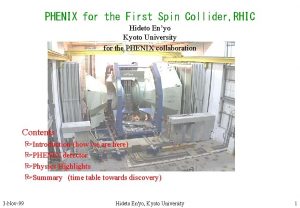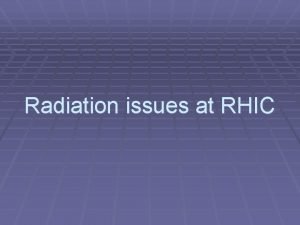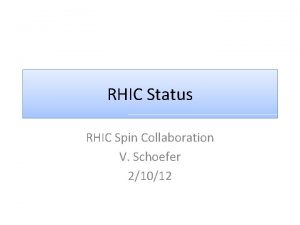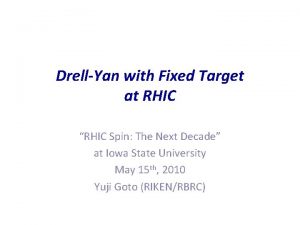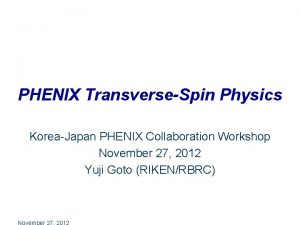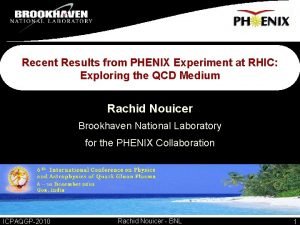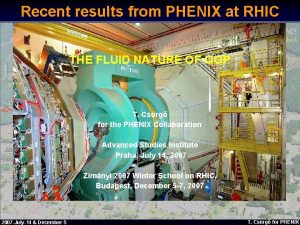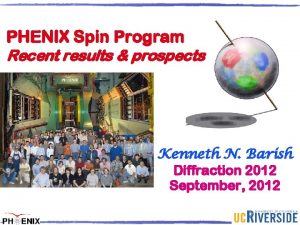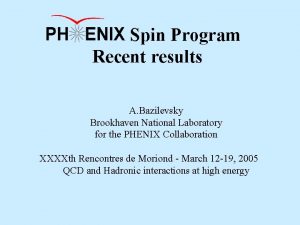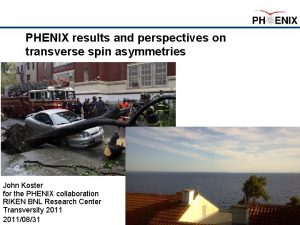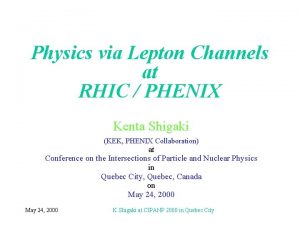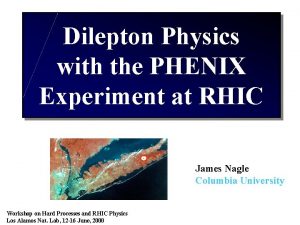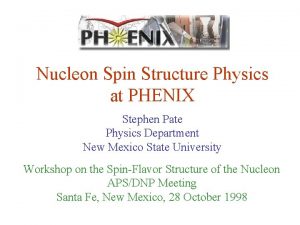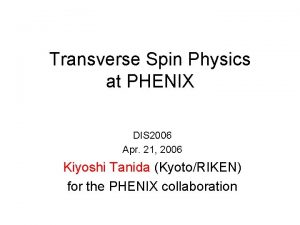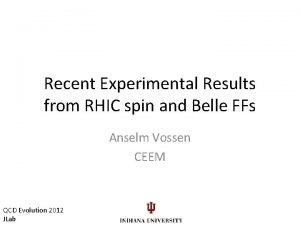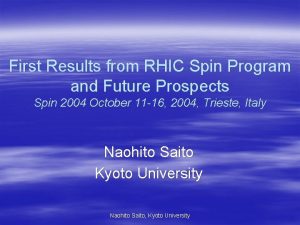Spin physics with PHENIX RHIC Run2 pp Results

























- Slides: 25

Spin physics with PHENIX RHIC Run-2 p+p Results, Run-3 Preview and Future Measurements Douglas E. Fields University of New Mexico/Riken-BNL Research Center 5/20/2003 Douglas Fields for the PHENIX collaboration 1

5/20/2003 Douglas Fields for the PHENIX collaboration 2

Detector Overview Multi-purpose experiment: • Central Spectrometer • Electrons • Photons • Hadrons • Forward Spectrometer • Muons • Very Forward Detectors • Triggering • Centrality • Polarimetry 5/20/2003 Douglas Fields for the PHENIX collaboration 3

Detector Overview • West Arm • East Arm • • tracking: – DC, PC 1, PC 2, PC 3 • – DC, PC 1, TEC, PC 3 electron ID: • – RICH, – EMCal • tracking: electron & hadron ID: – RICH, TEC/ TRD, – TOF, EMCal photons: – EMCal • photons: – EMCal 5/20/2003 Douglas Fields for the PHENIX collaboration 4

Detector Overview • Muon Tracking • • Radial field magnets 3 stations of cathode strip chambers 100 m resolution/plane = 60 m resolution/station J/Y mass resolution = 160 Me. V • Muon Identification • • • 5 layers of Irocci tubes x-y planes between steel absorber / rejection ~ 10 -4 • Zero-Degree Calorimeters • • hadron calorimeter neutron sensitive • Beam-Beam Counters • • Quartz. Cherenkov radiators 3. 0 < | | < 3. 9 • Multiplicity. Vertex Detector – Silicon strip 5/20/2003 Douglas Fields for the PHENIX collaboration 5

Spin Physics Overview • PHENIX can see • Physics – Signal • Single transverse-spin asymmetry – – neutron 0 charged hadron single muon from decay – – neutrons in ZDC/SMD gg in EMCal charged hadron (BBC or Central Arms) single muons in Muon Arms • Gluon polarization – leading high pt in Central Arms – e, , e , , and D→ K – ee, in Central and Muon Arms – jet production – open heavy flavor – J/ • Flavor decomposed quark polarization – W± • New physics with parity violation – high p. T ± in Muon Arms – parity violating W± • Transversity 5/20/2003 Douglas Fields for the PHENIX collaboration 6

Transverse Spin Asymmetries • Neutron asymmetry observed in IP 12 while testing a local polarimeter designed to look for 0, g asymmetries: • “Left-Right” asymmetry measured for different slices in phi: 5/20/2003 Douglas Fields for the PHENIX collaboration 7

Phi Asymmetry • Successful measurement of forward neutron asymmetry. • Understood (? ) in terms of SMEM. • Large asymmetry gives good FOM for local (PHENIX) polarimetry. 5/20/2003 Douglas Fields for the PHENIX collaboration 8

Local Polarimeter at PHENIX Spin Rotators OFF Blue Run-03 Yellow Blue Spin Rotators ON, Almost… |P|=30%, PT=0% PL=30%) Spin Rotators ON, Current Reversed |P|=37%, PT=24% PL=28%) Yellow Spin Rotators ON, Correct! PB=35. 5% PB=37% Yellow Blue 5/20/2003 Blue Douglas Fields for the PHENIX collaboration Yellow 9

• Charged hadron asymmetry – Measured using BBC, – Hadrons in central arms – Decay muons in Muon Arms Normalized Yield Transverse Spin Asymmetries PYTHIA+Decay Real Data Distance from Absorber [cm] m L : Distance from Absorber /K Beam Event Vertex 80 cm 5/20/2003 Douglas Fields for the PHENIX collaboration 10

Longitudinal Double Spin Asymmetries proton beam or • Would like to measure prompt photon in coincidence with jet. • Requires higher luminosity and larger acceptance (STAR). • Instead, (for now) measure leading 0 as a measure of jet. gluon jet photon or proton beam DG(x) GS 95 prompt photon x 5/20/2003 Douglas Fields for the PHENIX collaboration 11

Longitudinal Double Spin Asymmetries • To determine DG, look at ALL: • R is the relative luminosity, and can be measured (to some accuracy) at PHENIX. • Our Goal: d. R/R < 0. 1% for each fill d. ALL < 2× 10 -3 (expected ALL for pions ~ 3× 10 -3 @PT=3 Ge. V/c) 5/20/2003 Douglas Fields for the PHENIX collaboration 12

Relative Luminosity • In order to investigate our ability to measure the relative (++ vs. +-) luminosity: – look at ratio of 2 detector scalars crossing-by-crossing: • a(i) = NA(i)/NB(i) – Ratio should be the same for all crossings (constant) if: • NA(i) = L * ε and NB(i) = L * ε – B is always BBCLL 1 A is one of the others (CH 2 -8). – Fit this by the expected pattern: Ratio of Zero-Degree Counter scalars to Beam-Beam Counter scalars, sorted by bunch crossing and fit to a constant. • a(i) = C[1+ALLPB(i)PY(i)] • C, ALL are the fitting parameters. – Precision of relative luminosity can be estimated by: • d. C/C – If c 2 of the fitting is bad, look for other factors in N(i). 5/20/2003 Douglas Fields for the PHENIX collaboration 13

Correction factors • What other factors could play a role in the determination of the scalar rate besides the luminosity? – Vertex width • Vertex width also measured crossing by crossing. • Look for a correlation of the ZDC/BBC ratio with the vertex width: – Good correlation • Can correct ratio for this factor. 5/20/2003 Douglas Fields for the PHENIX collaboration 14

Limit on Relative Luminosity Measurement • After correction for (measured) vertex width, the ratio of counts in the two detectors is consistent with constant up to our level of statistics • This means that if we apply correction for this the precision on R goes from: 0. 11% 0. 06% (syst. limited) 5/20/2003 (stat. limited) Douglas Fields for the PHENIX collaboration 15

Gluon Polarization • Next step: Measure cross-section as a test for perturbative QCD. • In Run-02, precise measure of 0 crosssection. • Test against perturbative QCD. 5/20/2003 Douglas Fields for the PHENIX collaboration 16

Gluon Polarization proton beam or gluon heavy flavor proton beam GS 95 DG(x) • PHENIX can measure J/Y → e + e - , + • Can also measure open heavy quark decay to single and dileptons (e±, ±, e+ -, e- +). • Future upgrades to detect offset vertex. cc e. X bb e X J/ x 5/20/2003 Douglas Fields for the PHENIX collaboration 17

Current J/Y From Run-02 • Using like-sign subtraction from lepton pairs: 5/20/2003 Douglas Fields for the PHENIX collaboration 18

Open Charm • Single muons or electrons • e- coincidence • Better: 5/20/2003 Douglas Fields for the PHENIX collaboration 19

SVT Upgrade Strawman design under investigation Pixel barrels (50 mm x 425 mm) Strip barrels (80 mm x 3 cm) Pixel disks (50 mm x 200 mm) ~1. 0% X 0 per layer barrel resolution < 50 mm forward resolution < 150 mm 1. 2<|h|<2. 4 |h|<1. 2 5/20/2003 Douglas Fields for the PHENIX collaboration 20

Spin Physics with SVT Upgrade • Jet-axis for photon+jet-axis constraint on x • c e, displaced vertex low-x S/B, D K high-x • b displaced J/ low/high-x, b e, displaced vertex high -x 5/20/2003 Douglas Fields for the PHENIX collaboration 21

Flavor Decomposed Quark Polarization • At = 500 Ge. V/c 2, PHENIX can measure W± decay to single, high pt muons. • W-production sensitive to polarized antiquark and quark distributions – interpretation of asymmetry theoretically well established – insensitive to fragmentation functions – insensitive to higher twist • Experimental challenge – acceptance for W X – 1 nb cross-section at 500 Ge. V – at 2*1032 cm-2 s-1 10000 W in 10 weeks – reduce interaction rate ~12 MHz to few k. Hz 5/20/2003 Douglas Fields for the PHENIX collaboration 22

Muon Cherenkov Trigger Upgrade • Possible solutions for an enhanced muon trigger: – – forward hodoscopes anode readout cherenkov detector nosecone calorimeter 5/20/2003 Douglas Fields for the PHENIX collaboration 23

Other Topics • Transversity • New Physics from Parity Violation 5/20/2003 Douglas Fields for the PHENIX collaboration 24

Summary • PHENIX is uniquely suited to the study of spin physics with a wide variety of probes. • Run-02 gave us a solid baseline for transverse spin asymmetry, and cross-sections. • So far, in Run-03, we have commissioned with longitudinal polarized protons (successful spin rotators) and are taking AMAP data for an ALL measurement using 0. • We have studied our relative luminosity systematics and can make an ALL measurement that is statistics limited. • We have an upgrade plan that will give us the triggers and vertex information that we need for precise future measurements of DG, Dq and new physics at higher luminosity and energy. 5/20/2003 Douglas Fields for the PHENIX collaboration 25
 Rhic
Rhic Rhic brookhaven
Rhic brookhaven Rhic ags users meeting 2020
Rhic ags users meeting 2020 Rhic
Rhic Spin spin coupling
Spin spin coupling Spin spin coupling
Spin spin coupling Low spin and high spin complex
Low spin and high spin complex Spin up spin down
Spin up spin down Hyperfine splitting
Hyperfine splitting Colloquial neutral literary words examples
Colloquial neutral literary words examples Phenix scan
Phenix scan Scan trip
Scan trip Professional and social jargonisms
Professional and social jargonisms Modern physics vs classical physics
Modern physics vs classical physics Physics ia format
Physics ia format University physics with modern physics fifteenth edition
University physics with modern physics fifteenth edition Selection rule for electronic transition
Selection rule for electronic transition Sequence echo de spin
Sequence echo de spin Electron spin
Electron spin Spin fin kysely
Spin fin kysely Atom jj thomson
Atom jj thomson Spin column
Spin column Larmor precession animation
Larmor precession animation Aram generator
Aram generator Electron spin resonance takes in
Electron spin resonance takes in Spin coat
Spin coat
